Financial Accounting Process Report - Finance Accounting Principles
VerifiedAdded on 2023/06/05
|6
|1200
|395
Report
AI Summary
This report provides a detailed analysis of the financial accounting process within the Australian context. It begins by outlining the regulatory framework that governs financial reporting in Australia, including the roles of APRA, ASIC, and the Reserve Bank of Australia, and the Australian Accounting Standard Board (AASB). The report then examines the process of accounting for non-current assets, revenue recognition under AASB 15, and liabilities. It differentiates between shares and debentures, highlighting their key differences in terms of ownership, return, convertibility, and control. The report references various sources including AASB standards and provides a comprehensive overview of financial accounting principles and practices.
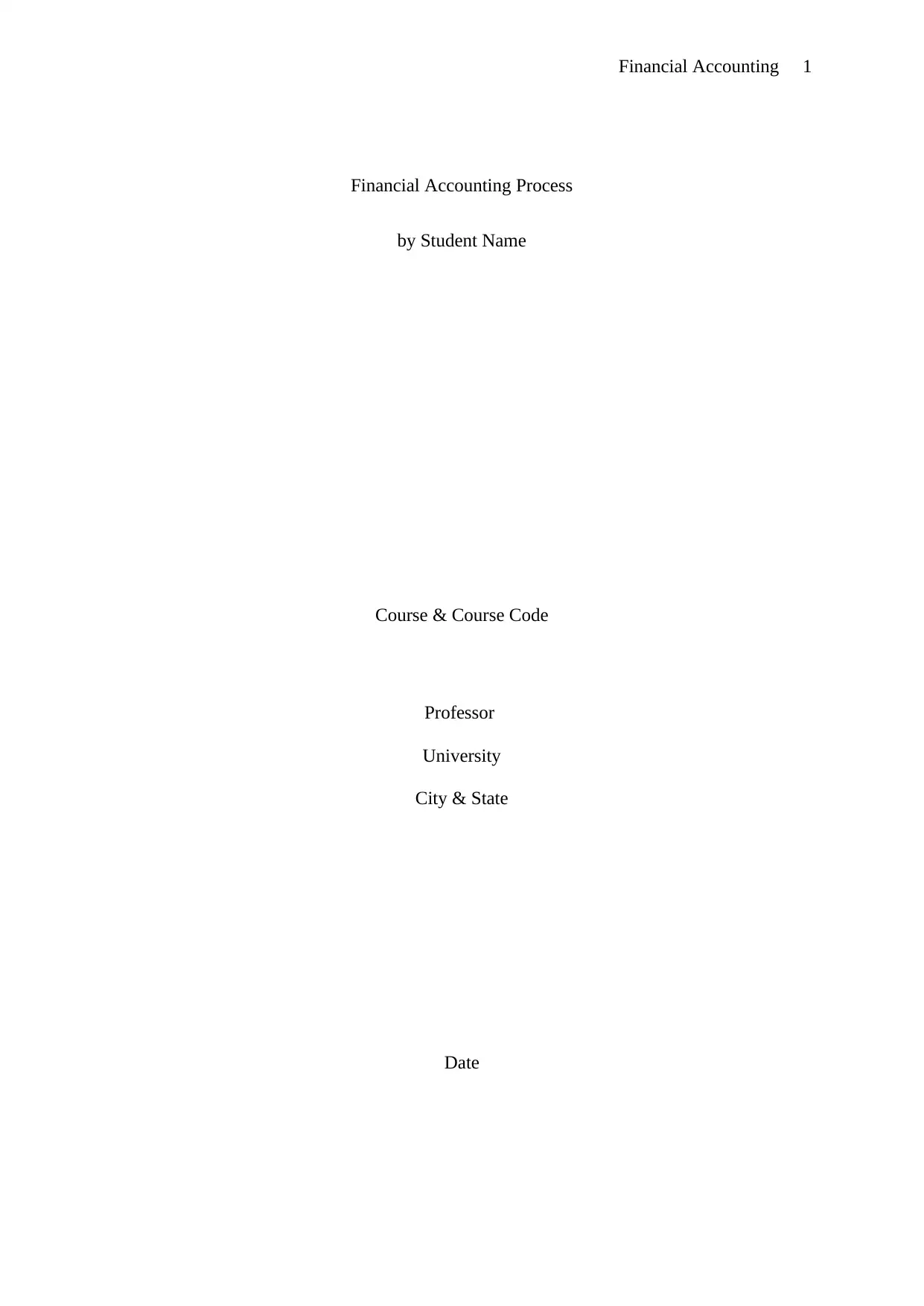
Financial Accounting 1
Financial Accounting Process
by Student Name
Course & Course Code
Professor
University
City & State
Date
Financial Accounting Process
by Student Name
Course & Course Code
Professor
University
City & State
Date
Paraphrase This Document
Need a fresh take? Get an instant paraphrase of this document with our AI Paraphraser
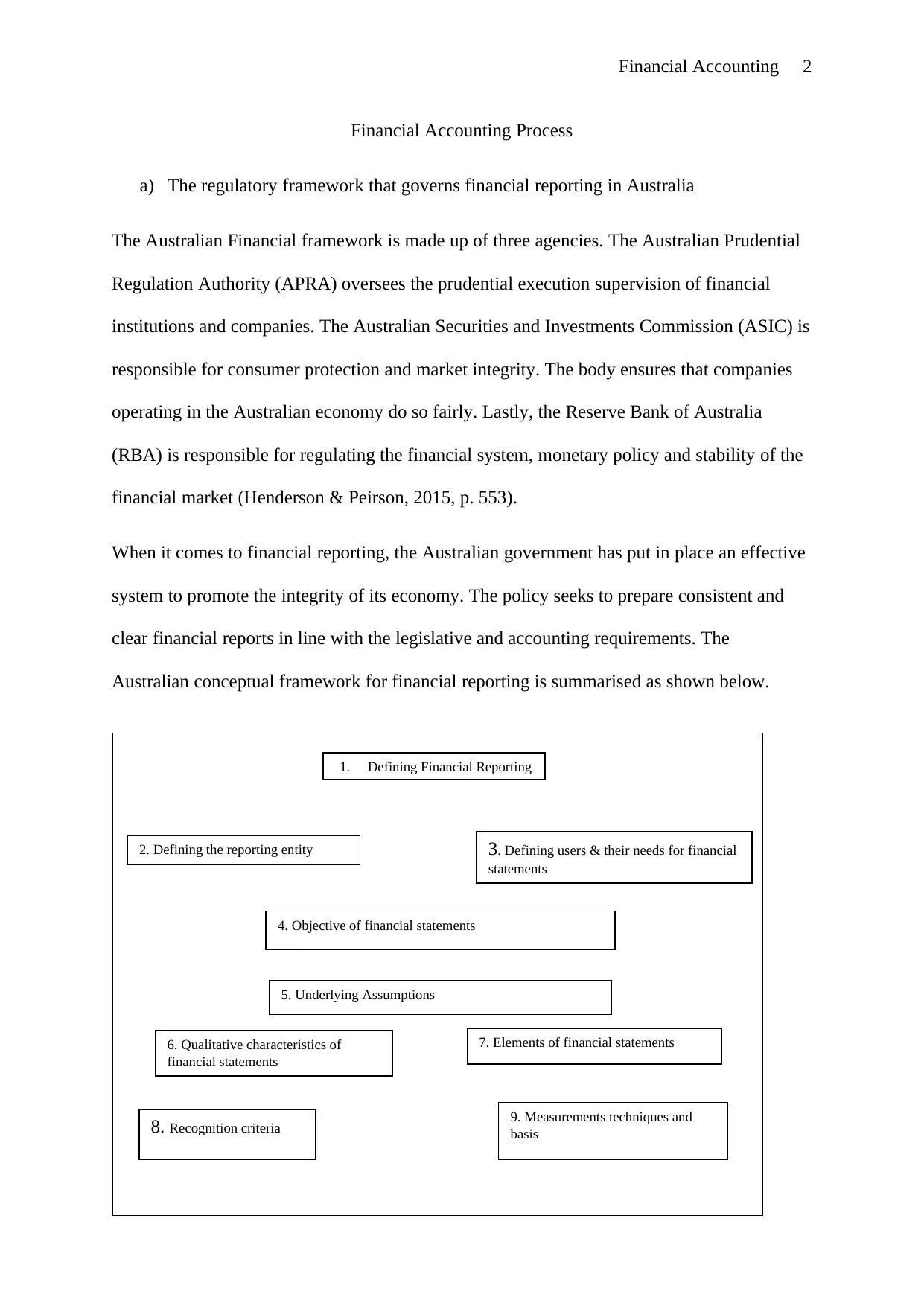
Financial Accounting 2
Financial Accounting Process
a) The regulatory framework that governs financial reporting in Australia
The Australian Financial framework is made up of three agencies. The Australian Prudential
Regulation Authority (APRA) oversees the prudential execution supervision of financial
institutions and companies. The Australian Securities and Investments Commission (ASIC) is
responsible for consumer protection and market integrity. The body ensures that companies
operating in the Australian economy do so fairly. Lastly, the Reserve Bank of Australia
(RBA) is responsible for regulating the financial system, monetary policy and stability of the
financial market (Henderson & Peirson, 2015, p. 553).
When it comes to financial reporting, the Australian government has put in place an effective
system to promote the integrity of its economy. The policy seeks to prepare consistent and
clear financial reports in line with the legislative and accounting requirements. The
Australian conceptual framework for financial reporting is summarised as shown below.
Xiaojing Wu is required to apply for the Business Activity Statement (BAS) with the
1. Defining Financial Reporting
2. Defining the reporting entity 3. Defining users & their needs for financial
statements
4. Objective of financial statements
5. Underlying Assumptions
6. Qualitative characteristics of
financial statements
7. Elements of financial statements
8. Recognition criteria 9. Measurements techniques and
basis
Financial Accounting Process
a) The regulatory framework that governs financial reporting in Australia
The Australian Financial framework is made up of three agencies. The Australian Prudential
Regulation Authority (APRA) oversees the prudential execution supervision of financial
institutions and companies. The Australian Securities and Investments Commission (ASIC) is
responsible for consumer protection and market integrity. The body ensures that companies
operating in the Australian economy do so fairly. Lastly, the Reserve Bank of Australia
(RBA) is responsible for regulating the financial system, monetary policy and stability of the
financial market (Henderson & Peirson, 2015, p. 553).
When it comes to financial reporting, the Australian government has put in place an effective
system to promote the integrity of its economy. The policy seeks to prepare consistent and
clear financial reports in line with the legislative and accounting requirements. The
Australian conceptual framework for financial reporting is summarised as shown below.
Xiaojing Wu is required to apply for the Business Activity Statement (BAS) with the
1. Defining Financial Reporting
2. Defining the reporting entity 3. Defining users & their needs for financial
statements
4. Objective of financial statements
5. Underlying Assumptions
6. Qualitative characteristics of
financial statements
7. Elements of financial statements
8. Recognition criteria 9. Measurements techniques and
basis
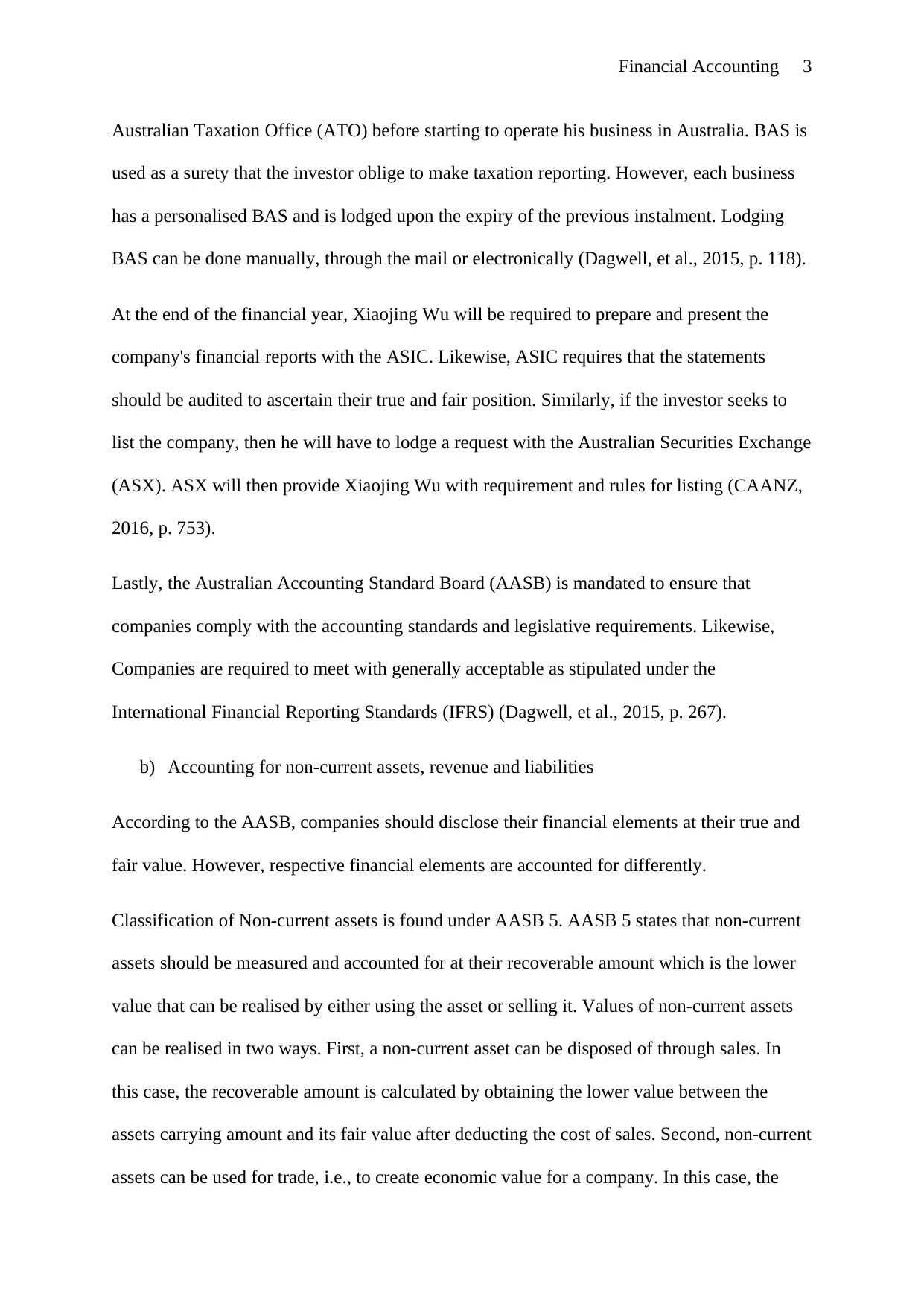
Financial Accounting 3
Australian Taxation Office (ATO) before starting to operate his business in Australia. BAS is
used as a surety that the investor oblige to make taxation reporting. However, each business
has a personalised BAS and is lodged upon the expiry of the previous instalment. Lodging
BAS can be done manually, through the mail or electronically (Dagwell, et al., 2015, p. 118).
At the end of the financial year, Xiaojing Wu will be required to prepare and present the
company's financial reports with the ASIC. Likewise, ASIC requires that the statements
should be audited to ascertain their true and fair position. Similarly, if the investor seeks to
list the company, then he will have to lodge a request with the Australian Securities Exchange
(ASX). ASX will then provide Xiaojing Wu with requirement and rules for listing (CAANZ,
2016, p. 753).
Lastly, the Australian Accounting Standard Board (AASB) is mandated to ensure that
companies comply with the accounting standards and legislative requirements. Likewise,
Companies are required to meet with generally acceptable as stipulated under the
International Financial Reporting Standards (IFRS) (Dagwell, et al., 2015, p. 267).
b) Accounting for non-current assets, revenue and liabilities
According to the AASB, companies should disclose their financial elements at their true and
fair value. However, respective financial elements are accounted for differently.
Classification of Non-current assets is found under AASB 5. AASB 5 states that non-current
assets should be measured and accounted for at their recoverable amount which is the lower
value that can be realised by either using the asset or selling it. Values of non-current assets
can be realised in two ways. First, a non-current asset can be disposed of through sales. In
this case, the recoverable amount is calculated by obtaining the lower value between the
assets carrying amount and its fair value after deducting the cost of sales. Second, non-current
assets can be used for trade, i.e., to create economic value for a company. In this case, the
Australian Taxation Office (ATO) before starting to operate his business in Australia. BAS is
used as a surety that the investor oblige to make taxation reporting. However, each business
has a personalised BAS and is lodged upon the expiry of the previous instalment. Lodging
BAS can be done manually, through the mail or electronically (Dagwell, et al., 2015, p. 118).
At the end of the financial year, Xiaojing Wu will be required to prepare and present the
company's financial reports with the ASIC. Likewise, ASIC requires that the statements
should be audited to ascertain their true and fair position. Similarly, if the investor seeks to
list the company, then he will have to lodge a request with the Australian Securities Exchange
(ASX). ASX will then provide Xiaojing Wu with requirement and rules for listing (CAANZ,
2016, p. 753).
Lastly, the Australian Accounting Standard Board (AASB) is mandated to ensure that
companies comply with the accounting standards and legislative requirements. Likewise,
Companies are required to meet with generally acceptable as stipulated under the
International Financial Reporting Standards (IFRS) (Dagwell, et al., 2015, p. 267).
b) Accounting for non-current assets, revenue and liabilities
According to the AASB, companies should disclose their financial elements at their true and
fair value. However, respective financial elements are accounted for differently.
Classification of Non-current assets is found under AASB 5. AASB 5 states that non-current
assets should be measured and accounted for at their recoverable amount which is the lower
value that can be realised by either using the asset or selling it. Values of non-current assets
can be realised in two ways. First, a non-current asset can be disposed of through sales. In
this case, the recoverable amount is calculated by obtaining the lower value between the
assets carrying amount and its fair value after deducting the cost of sales. Second, non-current
assets can be used for trade, i.e., to create economic value for a company. In this case, the
⊘ This is a preview!⊘
Do you want full access?
Subscribe today to unlock all pages.

Trusted by 1+ million students worldwide
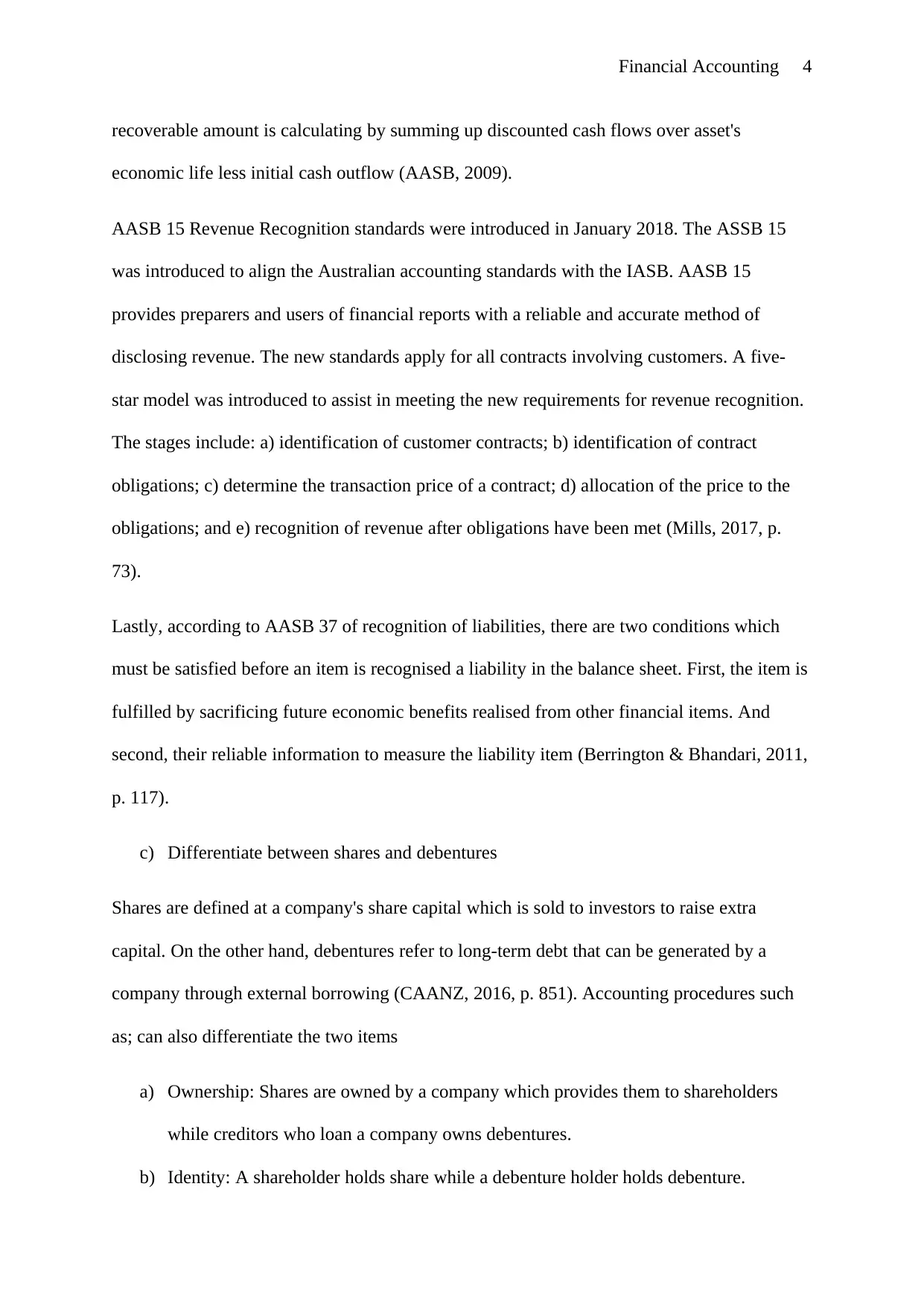
Financial Accounting 4
recoverable amount is calculating by summing up discounted cash flows over asset's
economic life less initial cash outflow (AASB, 2009).
AASB 15 Revenue Recognition standards were introduced in January 2018. The ASSB 15
was introduced to align the Australian accounting standards with the IASB. AASB 15
provides preparers and users of financial reports with a reliable and accurate method of
disclosing revenue. The new standards apply for all contracts involving customers. A five-
star model was introduced to assist in meeting the new requirements for revenue recognition.
The stages include: a) identification of customer contracts; b) identification of contract
obligations; c) determine the transaction price of a contract; d) allocation of the price to the
obligations; and e) recognition of revenue after obligations have been met (Mills, 2017, p.
73).
Lastly, according to AASB 37 of recognition of liabilities, there are two conditions which
must be satisfied before an item is recognised a liability in the balance sheet. First, the item is
fulfilled by sacrificing future economic benefits realised from other financial items. And
second, their reliable information to measure the liability item (Berrington & Bhandari, 2011,
p. 117).
c) Differentiate between shares and debentures
Shares are defined at a company's share capital which is sold to investors to raise extra
capital. On the other hand, debentures refer to long-term debt that can be generated by a
company through external borrowing (CAANZ, 2016, p. 851). Accounting procedures such
as; can also differentiate the two items
a) Ownership: Shares are owned by a company which provides them to shareholders
while creditors who loan a company owns debentures.
b) Identity: A shareholder holds share while a debenture holder holds debenture.
recoverable amount is calculating by summing up discounted cash flows over asset's
economic life less initial cash outflow (AASB, 2009).
AASB 15 Revenue Recognition standards were introduced in January 2018. The ASSB 15
was introduced to align the Australian accounting standards with the IASB. AASB 15
provides preparers and users of financial reports with a reliable and accurate method of
disclosing revenue. The new standards apply for all contracts involving customers. A five-
star model was introduced to assist in meeting the new requirements for revenue recognition.
The stages include: a) identification of customer contracts; b) identification of contract
obligations; c) determine the transaction price of a contract; d) allocation of the price to the
obligations; and e) recognition of revenue after obligations have been met (Mills, 2017, p.
73).
Lastly, according to AASB 37 of recognition of liabilities, there are two conditions which
must be satisfied before an item is recognised a liability in the balance sheet. First, the item is
fulfilled by sacrificing future economic benefits realised from other financial items. And
second, their reliable information to measure the liability item (Berrington & Bhandari, 2011,
p. 117).
c) Differentiate between shares and debentures
Shares are defined at a company's share capital which is sold to investors to raise extra
capital. On the other hand, debentures refer to long-term debt that can be generated by a
company through external borrowing (CAANZ, 2016, p. 851). Accounting procedures such
as; can also differentiate the two items
a) Ownership: Shares are owned by a company which provides them to shareholders
while creditors who loan a company owns debentures.
b) Identity: A shareholder holds share while a debenture holder holds debenture.
Paraphrase This Document
Need a fresh take? Get an instant paraphrase of this document with our AI Paraphraser
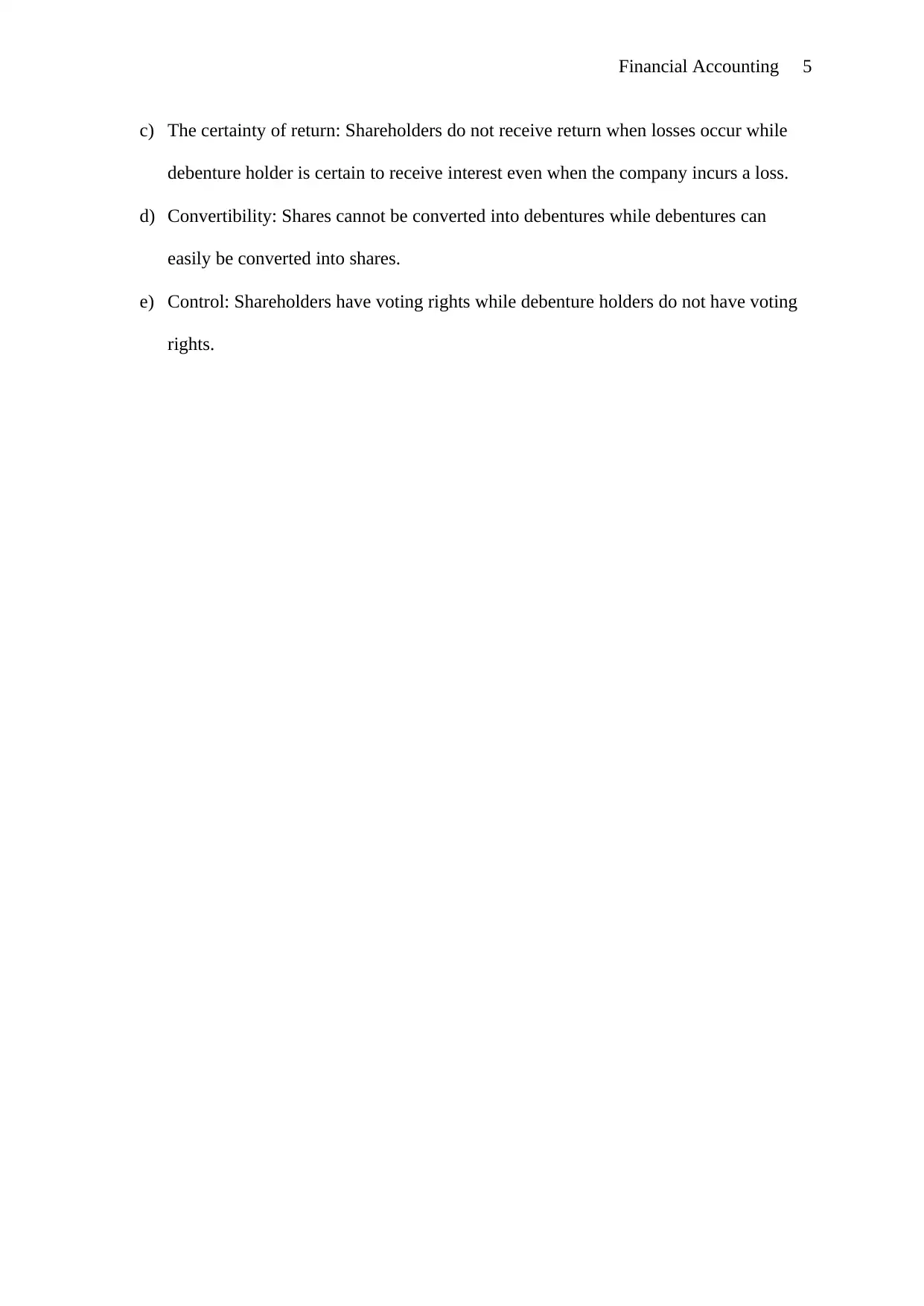
Financial Accounting 5
c) The certainty of return: Shareholders do not receive return when losses occur while
debenture holder is certain to receive interest even when the company incurs a loss.
d) Convertibility: Shares cannot be converted into debentures while debentures can
easily be converted into shares.
e) Control: Shareholders have voting rights while debenture holders do not have voting
rights.
c) The certainty of return: Shareholders do not receive return when losses occur while
debenture holder is certain to receive interest even when the company incurs a loss.
d) Convertibility: Shares cannot be converted into debentures while debentures can
easily be converted into shares.
e) Control: Shareholders have voting rights while debenture holders do not have voting
rights.
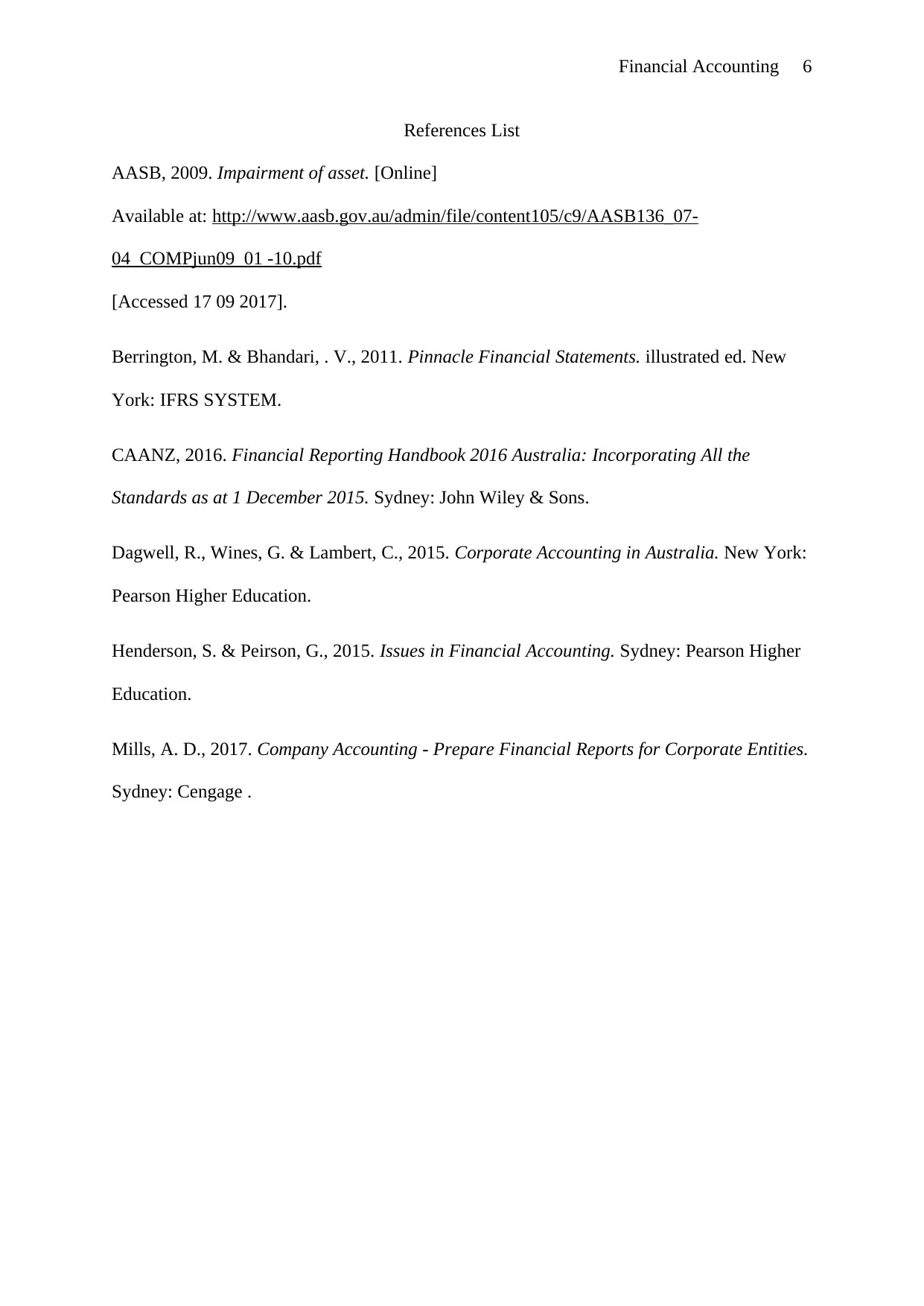
Financial Accounting 6
References List
AASB, 2009. Impairment of asset. [Online]
Available at: http://www.aasb.gov.au/admin/file/content105/c9/AASB136_07-
04_COMPjun09_01 -10.pdf
[Accessed 17 09 2017].
Berrington, M. & Bhandari, . V., 2011. Pinnacle Financial Statements. illustrated ed. New
York: IFRS SYSTEM.
CAANZ, 2016. Financial Reporting Handbook 2016 Australia: Incorporating All the
Standards as at 1 December 2015. Sydney: John Wiley & Sons.
Dagwell, R., Wines, G. & Lambert, C., 2015. Corporate Accounting in Australia. New York:
Pearson Higher Education.
Henderson, S. & Peirson, G., 2015. Issues in Financial Accounting. Sydney: Pearson Higher
Education.
Mills, A. D., 2017. Company Accounting - Prepare Financial Reports for Corporate Entities.
Sydney: Cengage .
References List
AASB, 2009. Impairment of asset. [Online]
Available at: http://www.aasb.gov.au/admin/file/content105/c9/AASB136_07-
04_COMPjun09_01 -10.pdf
[Accessed 17 09 2017].
Berrington, M. & Bhandari, . V., 2011. Pinnacle Financial Statements. illustrated ed. New
York: IFRS SYSTEM.
CAANZ, 2016. Financial Reporting Handbook 2016 Australia: Incorporating All the
Standards as at 1 December 2015. Sydney: John Wiley & Sons.
Dagwell, R., Wines, G. & Lambert, C., 2015. Corporate Accounting in Australia. New York:
Pearson Higher Education.
Henderson, S. & Peirson, G., 2015. Issues in Financial Accounting. Sydney: Pearson Higher
Education.
Mills, A. D., 2017. Company Accounting - Prepare Financial Reports for Corporate Entities.
Sydney: Cengage .
⊘ This is a preview!⊘
Do you want full access?
Subscribe today to unlock all pages.

Trusted by 1+ million students worldwide
1 out of 6
Related Documents
Your All-in-One AI-Powered Toolkit for Academic Success.
+13062052269
info@desklib.com
Available 24*7 on WhatsApp / Email
![[object Object]](/_next/static/media/star-bottom.7253800d.svg)
Unlock your academic potential
Copyright © 2020–2025 A2Z Services. All Rights Reserved. Developed and managed by ZUCOL.




